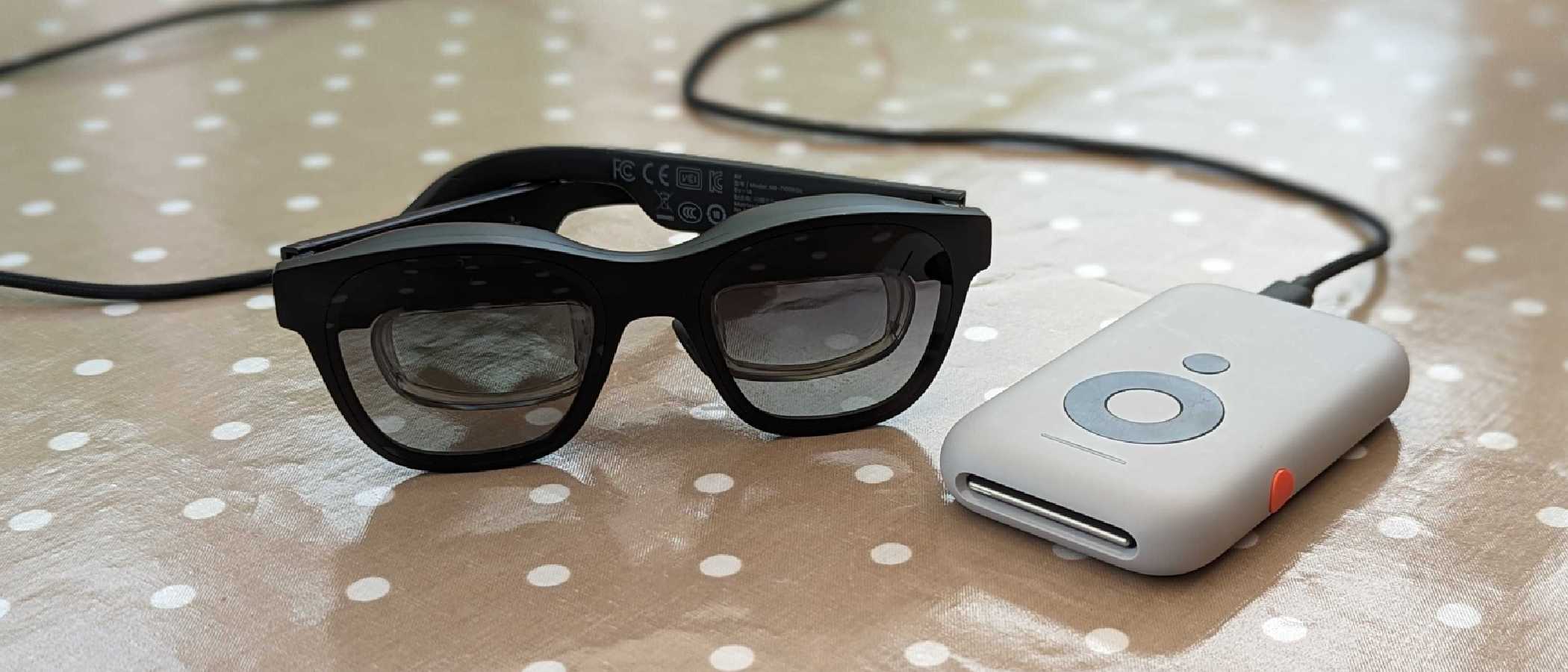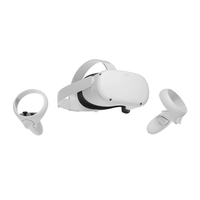TechRadar Verdict
The Xreal Air AR glasses still feel like they are purpose-built for early adopters. They’re undoubtedly a cool gadget, and the Beam adapter solves many of their issues, but they're still a bit too clunk and the price is a tad too steep.
Pros
- +
Lightweight
- +
Immersive HD cinema experience
- +
Look like a normal pair of glasses
Cons
- -
Pricey
- -
Limited compatibility without Beam
- -
Drain your phone's battery fast
Why you can trust TechRadar
Xreal Air AR Glasses: Two-minute review
The Xreal Air AR glasses aren't the first smart specs to hit the market, but thanks to their simple plug-and-play design and their great image quality they could be one of the first to achieve mainstream appeal.
Plug them into a compatible device – which includes a selection of the best Android smartphones, the Steam Deck, and now the best iPhones (via an adapter) – and you’ll be transported to your own virtual movie theater. Your gadget’s screen will be virtually projected in front of you by the glasses, allowing you to enjoy Netflix or Xbox Game Pass as if you were using a 130-inch HD TV.
Plus, thanks to the surprisingly decent internal speakers hidden in the glasses’ stems you can enjoy whatever you’re watching with immersive audio too. That said, I’d strongly recommend you couple the Xreal Air glasses with a good pair of wireless headphones – not only will you get much better audio performance, but the experience will be more private.
Considering that the Xreal Air AR specs look like a pretty normal pair of glasses – with a sleek yet comfy and fairly lightweight design – the performance they deliver is pretty impressive. Even though the glasses boast micro-OLED panels, the image is much more akin to what you’d expect from a projector in terms of contrast and colors (don’t expect Xreal’s specs to be an LG C2 OLED TV you can wear).
One noticeable feature the glasses lack is a camera. On the positive end, this means you don’t have to fret about your steps being tracked – or creeping out the people around you while you’re wearing the glasses. But this also means that the AR functionality of the Xreal Air glasses is extremely limited. They’re great for creating a cinema-like extension of your smartphone, but that’s about it.
Additionally, there are many devices out there that don't support the Xreal Air glasses because of hardware incompatibility. Xreal has launched the Beam adapter to combat this, but the $119 add-on isn't the perfect solution I hoped it would be (and is a hard sell considering the glasses themselves aren't cheap).
Because of this limited functionality, the price for a pair of the Xreal Air AR glasses can be a tough pill to swallow – they cost $379. While I had a blast trying this gadget out I feel like they don’t offer the most bang for your buck; those of you looking to improve your home entertainment setup would get more out of a solid 4K TV at this price, and commuters amongst you looking to liven up your travel would be better off with a great pair of headphones.
Xreal Air AR glasses: price and availability
The Xreal Air AR glasses are currently available to buy in the US for $379. They were previously available through EE in the UK for £400 (when they were known as Nreal Air), however, this partnership seems to have ended.

This price puts the Xreal Air glasses on par with other AR smart glasses, if not slightly cheaper than the competition. That said, while the AR smart glasses are impressive for a portable cinema the price will be tough for some people to justify. For the same money, you could a budget 4K TV, or buy a pair of the best wireless headphones (an upgrade that you may feel is a better investment if you want these glasses to keep you entertained on your daily commute).
The Xreal Beam adapter is also available in the US, and comes in at $119.
- Price score: 3/5
Xreal Air AR glasses: design
- No in-built cameras
- Lightweight
- Require a wired connection to a smartphone
Unlike some previous iterations of AR glasses, the Xreal Air look a lot more like a standard pair of specs. An eagle-eyed onlooker might spot a few key differences, but there aren’t any cameras so the AR aspect is not that obvious.
The decision to go camera-less instantly solves many of the privacy concerns that plagued previous devices, such as Ray-Ban Stories and Google Glass. You don’t have to worry about your vision being tracked, and those around you can rest easy knowing they aren’t being recorded without their consent.
Still, there are some signs that these aren’t regular glasses. In order for the Xreal Air to function, they need to be plugged into your phone. Using the USB-C to USB-C cable in the box, you can easily hook up your devices through a port hidden at the end of one of the glasses’ arms.
While not as free as a completely wireless device – like a pair of Bluetooth earbuds – I never had any issues moving my head around while plugged in. It caused so few issues while I was wearing the glasses that I actually completely forgot about the cable – until I went to take them off and it would snag on my ear.
The reliance on your phone's power means these glasses are pretty light, just 90g (0.2lbs) – they don't have an internal battery. But in exchange, they will drain your phone's battery fairly quickly, particularly if you're using them for an extended period of time.
The other dead giveaway that the Xreal Air aren't a normal pair of glasses is the inner lenses. These are what give the glasses their AR capabilities, reflecting an image of your phone’s screen in such a way that it appears to be floating in front of you.
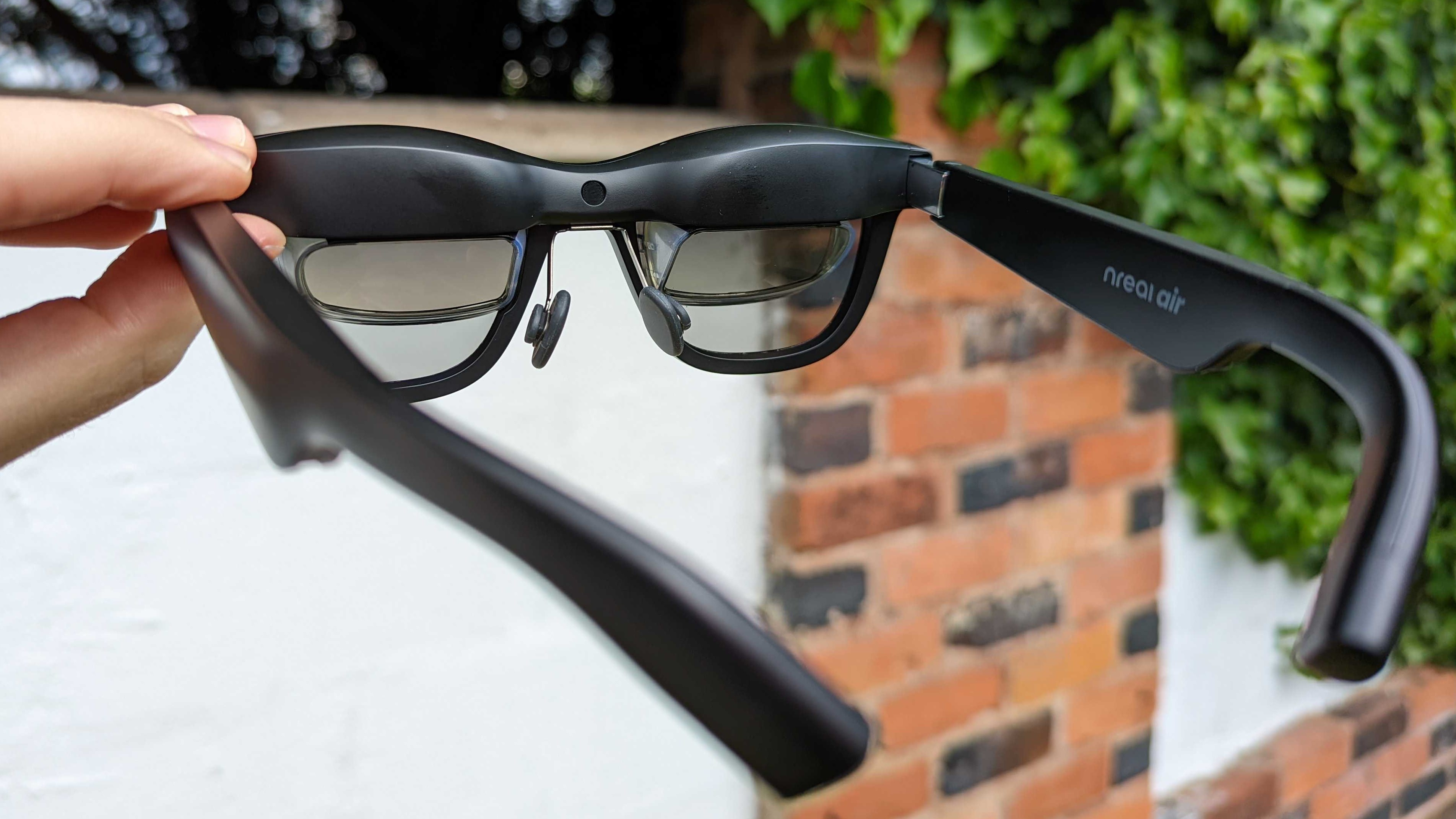
There are also two small speakers on either arm of the glasses, as well as brightness controls and an on/off button on the right arm. We never had much reason to dim the screen, so we definitely would have preferred the brightness controls on the arm be replaced by managed audio; to change the sound levels, you have to rely on your phone’s – or headphones’ – controls.
In addition to its power cable, every pair of Xreal Air glasses comes with a carry case that can be used to store it; additional nose pieces that you can use to help the glasses fit better; and an optional attachment that can be fitted with prescription lenses. You’ll also get a plastic lens cover. This cover will give your glasses some added protection as well as privacy and clarity, serving as a backdrop for what you’re watching to help make the image clearer.
I'd have preferred a reflective cover more like the one that comes with the TCL Nxtwear S glasses because while both options work just as well TCL's version looks more normal.
- Design score: 4/5
Xreal Air AR glasses: performance
- Solid HD image
- Mimics a 130-inch display that's 4m from the user's face
- For better sound try using headphones
The Xreal Air AR glasses are more like a portable personal projector than a TV that fits in your pocket.
By this, I mean that the image through the glasses is best when you’re looking at an opaque, plain background in a room that isn’t filled with bright light. If you’re outside or facing a light source, you’ll need to attach the optional visor to have any chance of seeing what’s being displayed.
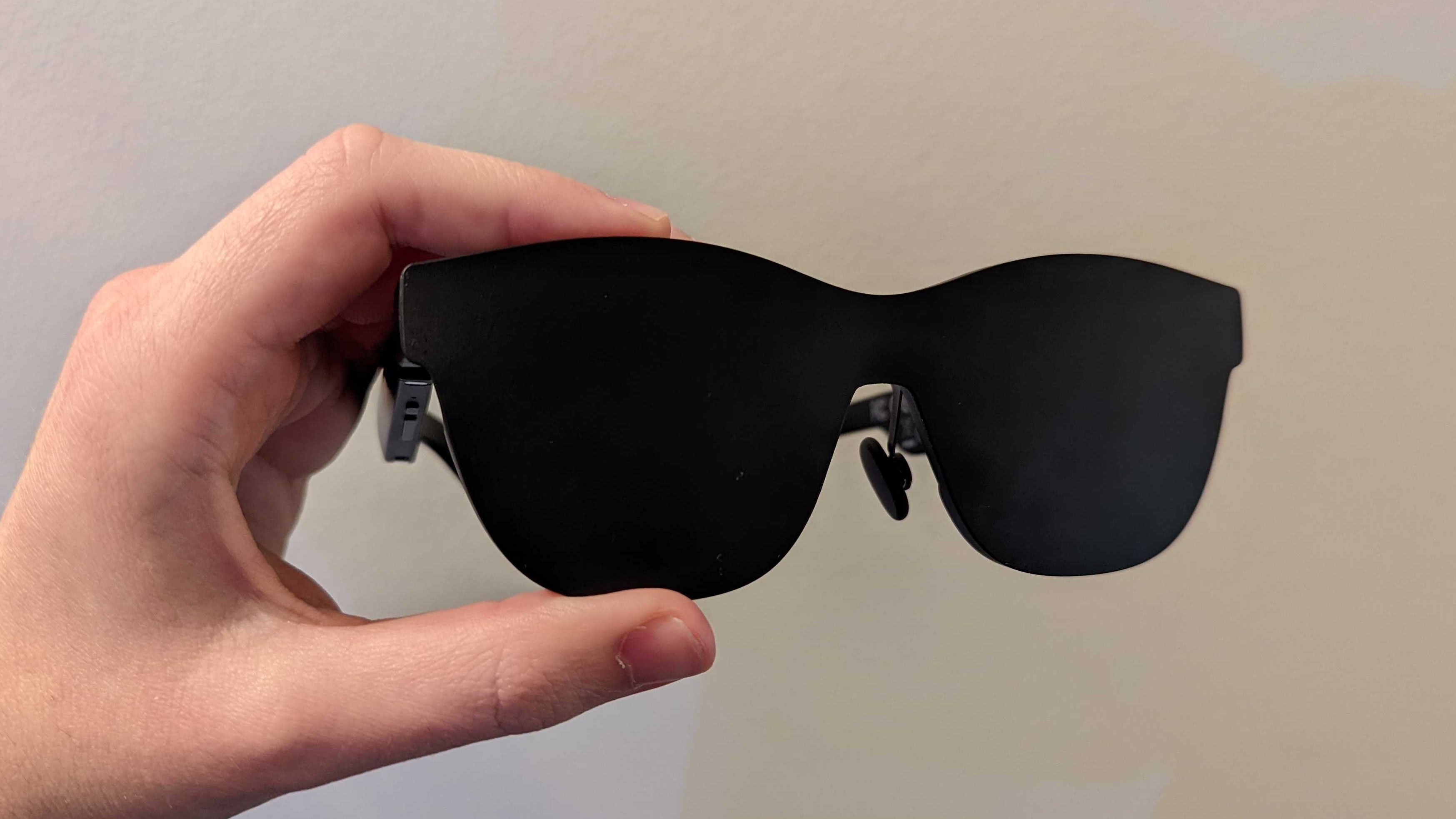
That being said, the glasses’ HD image is pretty impressive. The colors aren’t as vibrant as we’d like and the lack of 4K resolution is a little disappointing but the device’s relative screen size more than makes up for it. It’s roughly the same size as having a 130-inch TV 4m away from you – while not completely vision-filling, it is certainly more immersive than staring at your phone screen.
The audio performance is, in a word, fine. It’s certainly less dynamic than a great pair of headphones but is more than passable if you don’t mind those around you overhearing what you’re listening to. Thankfully, if you decide to use headphones, the AR glasses’ speakers will automatically mute themselves, just like your phone does.
- Performance score: 4/5
Xreal Air AR glasses: Compatibility
- Not all devices are compatible
- Beam can help, but it isn't perfect
It’s not just the glasses’ specs you need to think about though, as the Xreal Air are only compatible with certain smartphones. This includes the Sony Xperia 5 III, the Samsung Galaxy S22, and Oppo Find X5, in addition to several others you can find on the full official list. You can also hook it up to a few other handhelds like the Steam Deck and even Apple's M1 and M2-powered MacBooks.
And thanks to an Xreal Adapter you can connect them to one of the best iPhones out there and a Nintendo Switch now too, but it'll cost you $59. You'll also need to buy the $49 official Apple Lightning Digital AV adapter, effectively making the total cost of the glasses $487 for Apple fans.
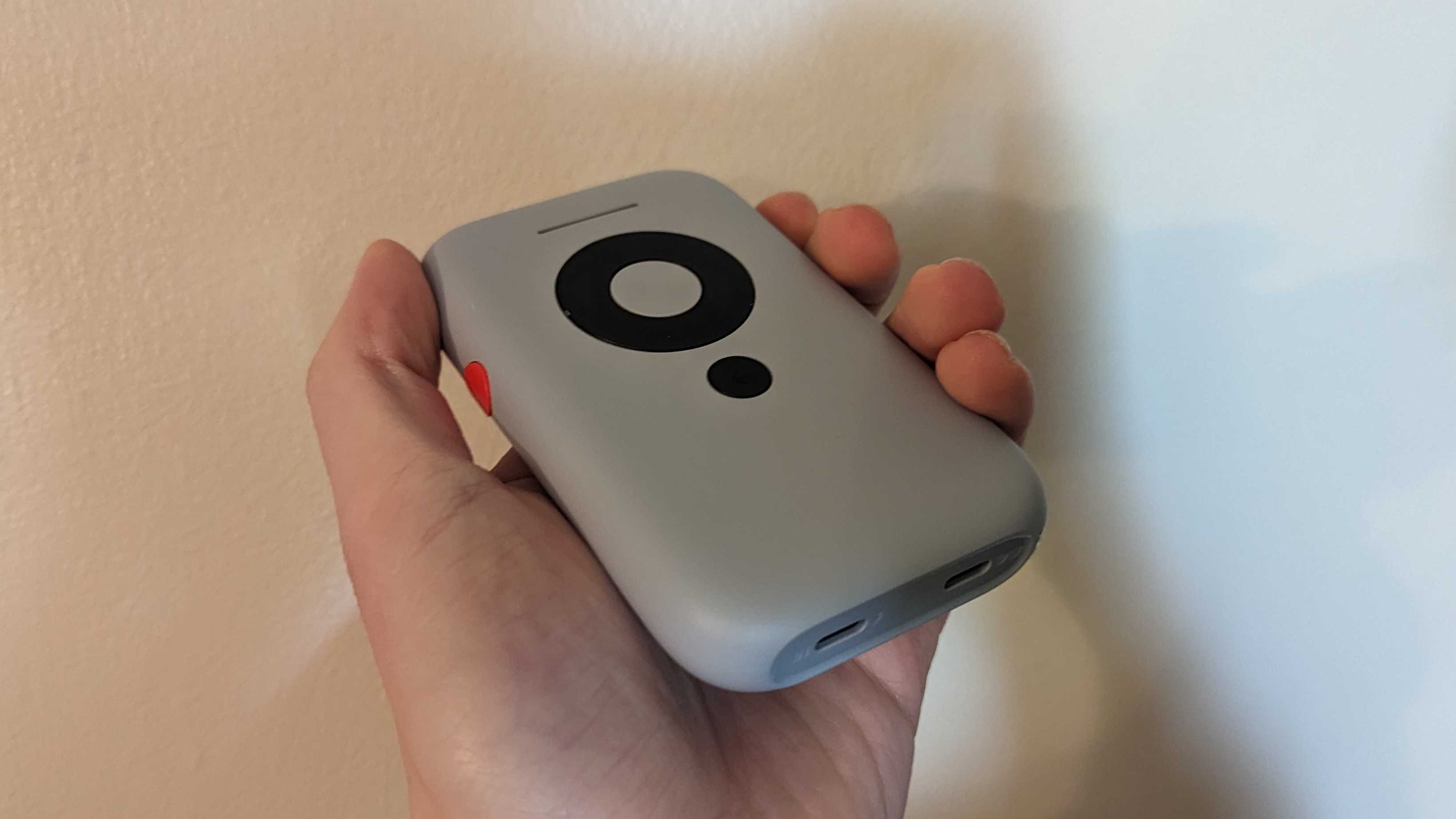
Alternatively, you can pick up the Xreal Beam, a new adapter for the Air glasses with a few extra benefits. For a start, the Beam makes it much simpler to connect non-compatible devices. For the Nintendo Switch, I just needed a USB-C to USB-C cable and then I could lie back in bed and enjoy playing Tears of the Kingdom on a massive virtual screen projected above me. This experience couldn’t have been better frankly. If you don't want a tangle of wires you can also connect your phone (including iPhones) to the Beam wirelessly.
The Beam not only expands the range of compatible products but helps to alleviate some of the battery drain problems – as the Air glasses will drain the Beam's power instead of your smartphone's.
Unfortunately, the Beam isn't quite perfect. Some devices – like the Google Pixel 7 and my Google Pixel 6 – aren't compatible. That's because the Pixel phones not only lack DisplayPort support but also use Google's proprietary Chromecast tech for casting (so they don't support third-party options like the Beam). As such, we'd recommend checking your phone is compatible before picking up the Air glasses or the Beam.
- Compatibility score: 3.5/5
Xreal Air AR glasses: features
- Limited feature set
- Clunky controls
The glasses aren’t just portable projectors though; they also open up access to exclusive AR features through the Nebula app.
The first is a virtual multi-monitor setup, allowing you to project multiple screens in front of you at once. While watching a YouTube live-streamed event on one screen, you can have an expert liveblog on another, a group chat with your friends on a third, and a store page opened up on a fourth so you can order everything you’re watching, reading, or chatting about on those other screens.
On the glasses’ massive-sized display, you’re able to have all this going on without having to shrink any windows down – everything is easy to see even when you have several open at once. Unfortunately, this feature is severely limited by the lack of cameras in the Xreal Air glasses.
To move these windows around and open them up in the first place, you have to use your phone. Unfortunately, the controls are a bit too clunky to make this an enjoyable experience and make me wish the glasses had cameras. Rather than blindly swiping on your phone screen, you could pinch your fingers together and type on a floating keyboard, giving you a true Tony Stark-like experience.
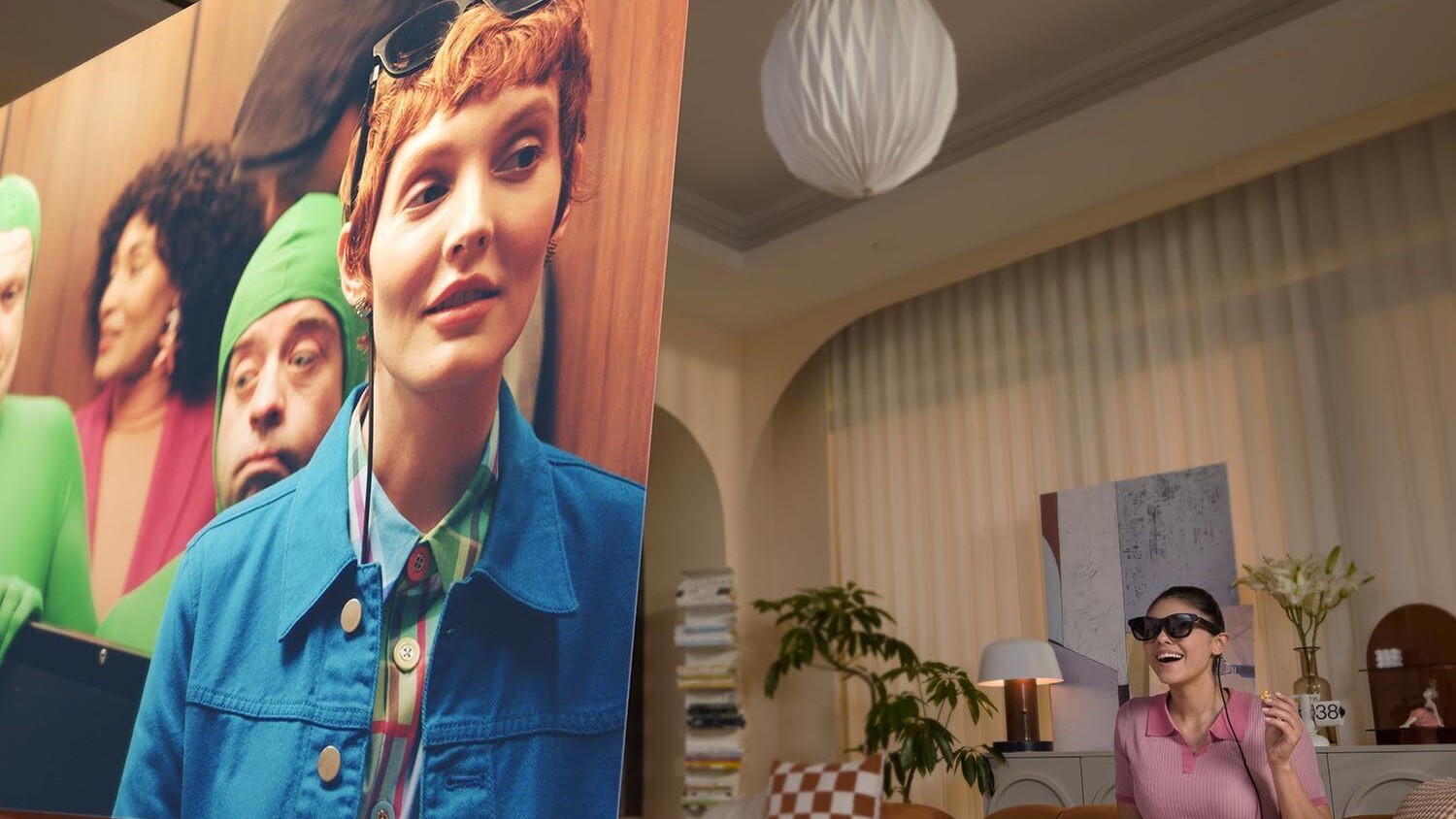
Then there’s the cycling app. Borrowing from services like Peloton, this feature transports you from your gym to a cycle path by playing a video of a fellow cyclist out there making the journey themselves. It’s fine, but nothing to write home about. If you’re after an immersive workout, you’d be better off grabbing a VR headset and trying out some of the best VR fitness games.
Once again, the glasses could offer much better experiences by being able to capture the world around you with cameras. They could digitally map realistic virtual objects into the world that you could interact with, but instead, these glasses go no further than pasting images at a set distance in front of your face.
- Features score: 2/5
Xreal Air AR glasses: battery life
- No internal battery
- Can really drain your phone's charge with prolonged use
Because the Xreal Air AR glasses plug straight into your smartphone without the ability to operate wirelessly, they don’t have or need an internal battery. But without their own battery, these glasses will significantly drain the battery life of the device to which you connect them.
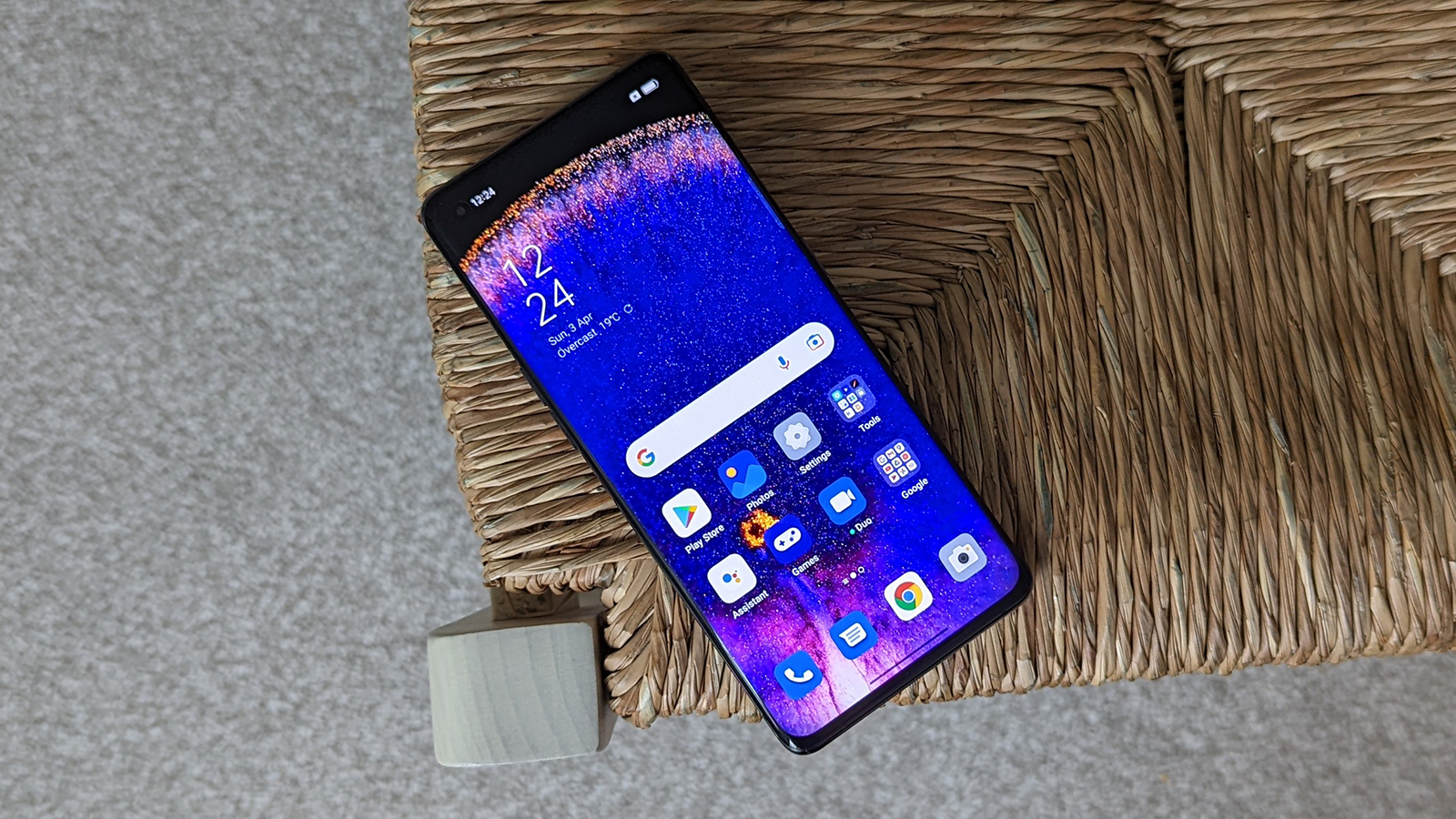
Using the Xreal glasses with a pair of Bose 700 Bluetooth headphones to stream Netflix over 5G on an Oppo Find X5 was enough to drain the phone’s charge by about 50% over my hour-long commute.
If you find this to be an issue we'd recommend picking up the Beam adapter as this can spare your phone, though we wish we didn't need a $119 to solve this issue. In the next iteration, I'd love to see the glasses or their cable offer a second USB-C port so that I can connect my glasses, phone, and power source together simultaneously.
- Battery life score: 3/5
Should I buy the Xreal Air AR glasses?
Buy these if…
You have a decent-length commute
If you’re commuting for at least 30 minutes each way on public transport, these AR glasses will probably help to keep you entertained for the whole journey.
You want to be an early adopter
These Xreal Air glasses will give you a taste of what AR devices could add to our lives. If you want a feel for some features at the forefront of tech – with all the perks and negatives that come with that – these could be for you.
You have reliable 5G access
These glasses are at their best on a reliable 5G network that lets you stream Netflix and Xbox Game Pass with ease wherever you are.
Don’t buy these if…
You don’t use the right smartphone
If your smartphone isn’t on the list of supported devices, don’t bother with these glasses – you won’t be able to use them.
You want to experience the early metaverse
If you’re looking to dip your toes into the early metaverse, this isn’t the AR or VR gadget for you. While it offers a very different use case, something like the Meta Quest 2 will be a significantly better choice.
You’re trying to cut costs
At $375 / £400, these glasses aren’t a budget-friendly piece of tech.
Also consider
Sony WH-1000XM4 wireless headphones
If you’re looking to upgrade your commute to work, you could choose to go with something like the Sony WH-1000XM4 wireless headphones. Instead of improving your visual experience, you’ll get a much better audio performance from your podcasts, playlists and any videos you choose to watch on the way to work – plus they only cost $280 / £279 / AU$395. Deals mean you can sometimes find them for even less these days.
Meta Quest 2
The Meta Quest 2 won’t offer the portable TV experience that the Xreal Air glasses do, but it still remains our top recommendation for those looking to enter the early metaverse powered by AR and VR gadgets.
Xreal Air AR Glasses scorecard
| Attribute | Notes | Score |
|---|---|---|
| Design | These AR glasses have a sleek design that ensures they're comfortable to wear and they look like a fairly normal pair of glasses. | 4/5 |
| Performance | While these AR glasses can't do a lot, they're great at the one thing they can do: giving you a portable yet immersive cinema experience. | 4/5 |
| Features | Apart from the cinema experience, you won't get much else of worth out of these specs. | 2/5 |
| Battery life | While these glasses don't have their own battery life, they will really drain the charge of your smartphone if you aren't careful. | 3/5 |
| Value | Unfortunately, the Xreal Air AR glasses just don't do quite enough to fully justify their price right now. | 3/5 |
How we test
We pride ourselves on our independence and our rigorous review-testing process, offering up long-term attention to the products we review and making sure our reviews are updated and maintained - regardless of when a device was released, if you can still buy it, it's on our radar.
First reviewed June 2022

Hamish is a Senior Staff Writer for TechRadar and you’ll see his name appearing on articles across nearly every topic on the site from smart home deals to speaker reviews to graphics card news and everything in between. He uses his broad range of knowledge to help explain the latest gadgets and if they’re a must-buy or a fad fueled by hype. Though his specialty is writing about everything going on in the world of virtual reality and augmented reality.
